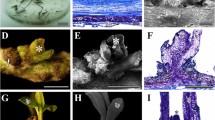Abstract
Super roots (SR) of Lotus corniculatus are a fast growing legume root culture that allows continuous root cloning, direct somatic embryogenesis and mass regeneration of plants under entirely growth regulator-free culture conditions. These features are unique to root cultures and are now stably expressed since the culture was isolated more than 5 years ago. Super roots switch from exclusive root proliferation to shoot production upon transfer to illuminated and stationary conditions. Lateral root formation continues at a reduced rate while embryos and shoots are forming. When infected with Rhizobium loti, SR carrying somatic embryos and small shoots, form root nodules. Regenerating SR provide evidence that root-derived somatic embryos and shoots of L. corniculatus begin to form in a process related to the development of lateral roots or root nodules. When treated with a low concentration of benzylamino purine (BAP), shoots form at an increased rate, matching the spacing typical for lateral roots. The super-growing root culture of L. corniculatus regenerates plants that show no morphological differences as compared to regenerants from wild-type roots or seedlings. Roots dissected from plantlets derived from SR or from super root-derived protoplasts express all super root qualities again when cultured in vitro. Super roots provide a favorable experimental system for developmental studies that are sensitive to exogenous hormones, such as lateral root formation or nodulation in vitro.
Similar content being viewed by others
References
Akashi R, Hoffmann-Tsay S-S and Hoffmann F 1998 Selection of a super-growing legume root culture that permits controlled switching between root cloning and direct embryogenesis. Theor. Appl. Genet. 96, 758–764.
Akashi R, Harris S, Hoffmann-Tsay S-S and Hoffmann F 2000 Plants from protoplasts isolated form a long-term root culture (super root) of Lotus corniculatus. J. Plant Physiol. 157, 215–221.
Chilton M D, Tepfer D A, Petit A, David C, Casse-Delbert F and Tempe J 1982 Agrobacterium rhizogenes inserts T-DNA into the genomes of the host plant root cells. Nature 295, 432–434.
Curtis W R 1993 Cultivation of roots in bioreactors. Curr. Opinion Biotech. 4, 205–210.
David C, Chilton M D and Tempe J 1984 Conservation of T-DNA in plants regenerated from hairy root cultures. BioTechnology 2, 73–76.
Grant WF and Marten G C 1985 Bird's-foot trefoil. In Forages: The Sciences of Grassland Agriculture. Eds. M E Heath, R F Barnes and D S Metcalfe. pp. 98–108. Iowa State Univ. Press, Ames.
Gresshoff P M, Men A E, Maguire T, Grimmond S, Lohar D, Ayanru S, Meksem K, Lightfoot D and Stiller J 2000 An integrated functional genomics and genetics approach for the plant's function in symbiotic nodulation. In Molecular Breeding of Forage Crops. Ed. G. Spangenberg. pp. 275–283. Lorne and Hamilton, Victoria, Australia.
Handberg K and Stougaard J 1992 Lotus japonicus, an autogamous, diploid legume species for classical and molecular genetics. Plant J. 2, 487–496.
Hoffmann F, Akashi R and Hoffmann-Tsay S-S 1999 Nodulation in legume root cultures: micrografted or regenerated shoots can reestablish the potential for nodulation in cultured roots. In Utilization of Transgenic Plants and Genome Analysis in Forage Crops. Ed. H Nakagawa and M Kobayashi. pp. 67–73. National Grassland Research Institute Japan, Tochigi.
Kao K M and Michayluk M R 1975 Nutritional requirements for growth of Vicia hajastana cells and protoplasts at a very low population density in liquid media. Planta 126, 105–110.
Kawano T, Hashiguchi M, Akashi R and Hoffmann F 2001 Morphological and biochemical characterization of super roots in Lotus corniculatus. Proc. 11th Annu. Meeting Plant-Microbe Interaction. Japanese Society of Plant-Microbe Interactions, Miyazaki.
Murashige T and Skoog F 1962 A revised medium for rapid growth and bioassays with tobacco tissue culture. Physiol. Plant. 15, 471–497.
Petit A, Berkaloff A and Tempe J 1986 Multiple transformation of plant cells by Agrobacterium may be responsible for the complex organization of T-DNA in crown gall and hairy root. Mol. Gen. Genet. 202, 388–393.
Seaney R R and Henson P R 1970 Bird's-foot trefoil. Adv. Agron. 22, 119–157.
Swanson E B, Somers D A and Tomes D T 1990 Bird's-foot trefoil (Lotus corniculatus L.). In Biotechnology in Agriculture and Forestry, Vol. 10, Legumes and Oilseed Crops. Ed. Y P S Bajaj. pp. 323–340. Springer-Verlag, Berlin.
Tepfer D 1984 Transformation of several species of higher plants by Agrobacterium rhizogenes: sexual transmission of the transformed genotype and phenotype. Cell 37, 957–967.
White P R 1934 Potentially unlimited growth of excised tomato root tips in a liquid medium. Plant Physiol. 9, 585–600.
Author information
Authors and Affiliations
Corresponding author
Rights and permissions
About this article
Cite this article
Akashi, R., Kawano, T., Hashiguchi, M. et al. Super roots in Lotus corniculatus: A unique tissue culture and regeneration system in a legume species. Plant and Soil 255, 27–33 (2003). https://doi.org/10.1023/A:1026143606752
Issue Date:
DOI: https://doi.org/10.1023/A:1026143606752



